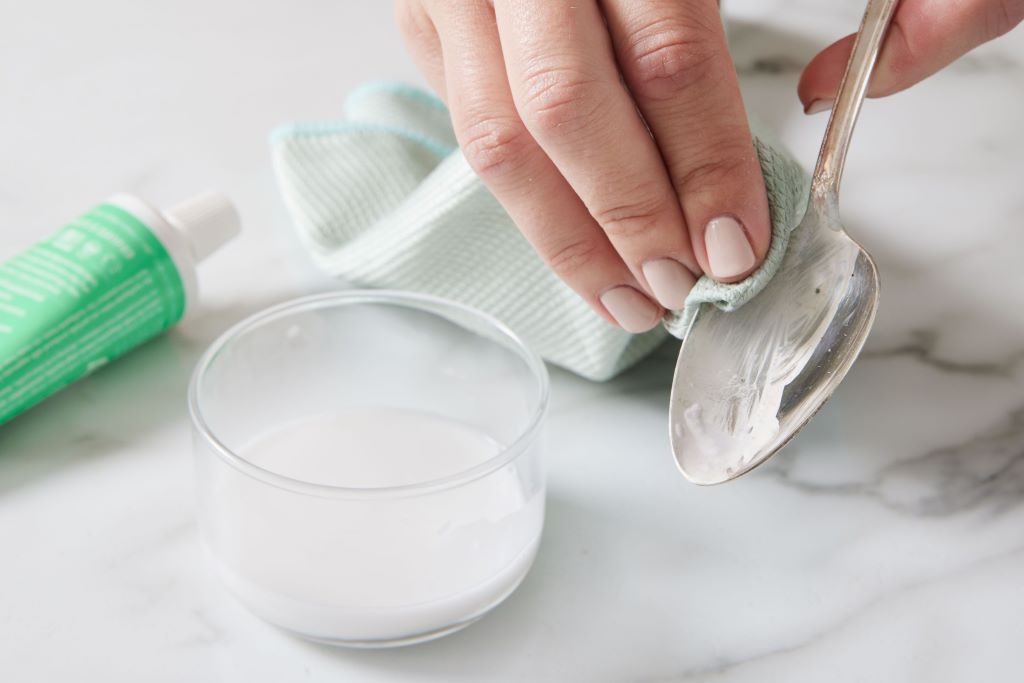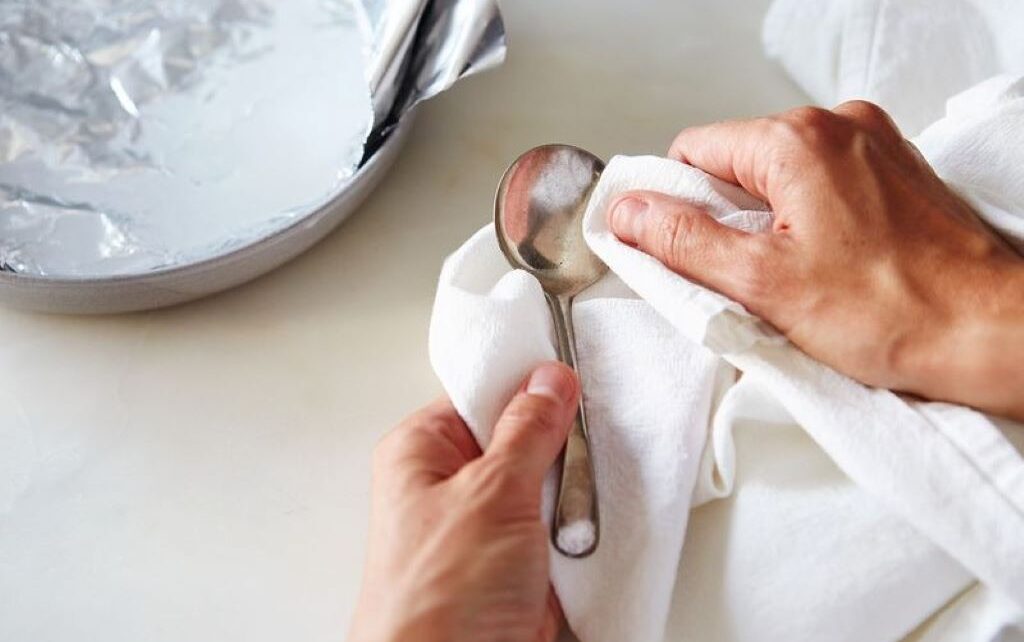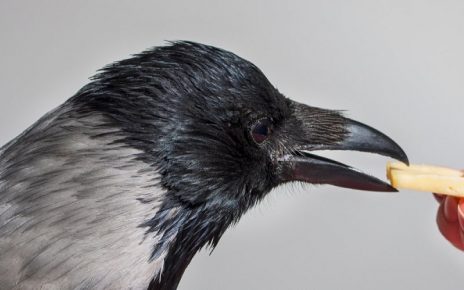Silver cutlery holds elegance, nostalgia, and often, real value. But time turns its beauty dull with stubborn tarnish. If your once-gleaming spoons, forks, or knives now wear a grey-black patina, don’t worry. You don’t need harsh chemicals or abrasive scrubbing to bring them back to life. Here’s a detailed, expert-backed guide to safe cleaning methods for tarnished silver cutlery—rooted in science, tested in real homes, and trusted by professionals.
Why Silver Tarnishes in the First Place
Tarnish is the result of a chemical reaction between silver and sulfur-containing substances in the air. This reaction forms silver sulfide, a dark compound that coats the metal. Everyday exposure to moisture, air pollution, rubber, wool, and even certain foods like eggs accelerates this tarnishing.
According to the American Chemical Society, even indoor environments contain trace sulfur compounds that contribute to this process.
The Danger of Harsh Silver Cleaners
Some commercial silver polishes use abrasive ingredients or acids that can strip away delicate silver layers over time. Repeated use may cause pitting, scratches, or dull spots. Worse, residual polish might leach into food if not rinsed properly.
Consumer reviews often mention skin irritation, strong odors, or silver becoming more prone to tarnishing afterward. That’s why professionals favor gentler alternatives.
Safe Cleaning Methods for Tarnished Silver Cutlery
These proven, safe methods clean effectively without damaging the surface or exposing you to toxic chemicals. Use them for regular upkeep or deep restoration.
-
Baking Soda and Aluminum Foil Method (Electrochemical Reaction)
Best for: Deep tarnish, full sets of silverware
Tools needed: Aluminum foil, glass baking dish, baking soda, boiling water
How it works: This method reverses tarnish through a safe, non-abrasive chemical reaction. The baking soda and hot water create an electrolytic bath where silver sulfide transfers to aluminum.
Instructions:
- Line a dish with foil (shiny side up).
- Add silverware, ensuring contact with the foil.
- Pour in boiling water.
- Add 1 tablespoon baking soda per cup of water.
- Let sit for 5 minutes, rinse and dry.
Logic: This doesn’t remove silver; it converts silver sulfide back to silver. Harvard researchers back this electrochemical process as non-damaging and effective.
-
White Vinegar and Baking Soda Soak
Best for: Mild to moderate tarnish
Tools needed: Baking soda, white vinegar, glass bowl
How it works: The fizzing reaction lifts tarnish gently without abrasion. It’s particularly effective for intricate designs or filigree cutlery.
Instructions:
- Mix ½ cup white vinegar and 2 tablespoons baking soda.
- Soak silverware for 2–3 hours.
- Rinse thoroughly, dry with a soft cloth.
Tip: Avoid this method on silver-plated items. Acidity may wear thin layers.
-
Cornstarch Paste Polish
Best for: Targeted polish and shine
Tools needed: Cornstarch, water, microfiber cloth
How it works: Cornstarch dries into a mild polishing agent. It’s eco-friendly and easy to apply to tarnished spots.
Instructions:
- Mix cornstarch and water to form a paste.
- Apply with a soft cloth.
- Let dry completely.
- Buff gently with microfiber.
Expert tip: Add a drop of lemon juice for extra sparkle. It won’t harm your silver but lifts grime better.
-
Toothpaste (Non-Gel, Non-Whitening)
Best for: Spot-cleaning severe tarnish
Tools needed: Soft toothbrush, water, non-gel white toothpaste
How it works: Toothpaste contains mild abrasives like hydrated silica that gently polish metal.
Instructions:
- Dab a pea-sized amount onto a soft brush.
- Gently scrub silverware.
- Rinse and dry.
Warning: Avoid whitening pastes. They contain bleaching agents that may scratch or corrode silver.
-
Olive Oil and Lemon Juice Polish
Best for: Natural shine and gentle cleansing
Tools needed: Lemon juice, olive oil, soft cloth
How it works: Lemon juice cuts grease while olive oil protects the surface. Ideal for light maintenance.
Instructions:
- Mix ½ cup lemon juice and 1 teaspoon olive oil.
- Dip a soft cloth and rub the silverware.
- Buff with a clean cloth for shine.
Bonus: Leaves a pleasant citrus scent.

Professional Tips for Maintaining Silver Cutlery
- Use anti-tarnish cloths: Store silver in specially treated cloths that absorb sulfur and moisture.
- Avoid rubber bands or newspaper: Both emit compounds that hasten tarnish.
- Rinse after use: Wash cutlery immediately after exposure to acidic foods.
- Dry completely: Moisture accelerates tarnish and encourages corrosion.
- Limit dishwasher use: Harsh detergents and high heat can damage silver. Always hand wash.
According to a 2024 survey by SilverCare Magazine, over 65% of silver collectors prefer hand-cleaning with natural methods for better preservation.
Featured Snippet (Trending Question Answer)
What is the safest way to clean heavily tarnished silver cutlery at home?
The safest way to clean heavily tarnished silver cutlery at home is the baking soda and aluminum foil method. This technique uses a gentle electrochemical reaction to convert tarnish (silver sulfide) back into silver without scratching the surface. Line a container with aluminum foil, add boiling water and baking soda, then place silverware in contact with the foil. Let it sit for five minutes, rinse thoroughly, and dry. It’s safe, eco-friendly, and approved by conservationists for its non-abrasive properties.
Real User Reviews on Safe Silver Cleaning
“I tried the baking soda method—WOW. Zero effort and my grandmother’s silverware looked brand new!” – Janice R., Oregon
“The vinegar soak worked wonders on my vintage spoons. I won’t go back to chemical polishes.” – Mark T., New York
“Used olive oil and lemon for a light shine before guests arrived. Great for a quick refresh!” – Linda C., Texas
FAQs: Safe Cleaning Methods for Tarnished Silver Cutlery
-
Can I use dish soap on silver cutlery?
Yes, mild dish soap is safe for regular cleaning. Avoid citrus-scented versions which may contain acidic oils.
-
Is it okay to clean silver cutlery in the dishwasher?
No. The harsh detergent and high heat can damage silver or cause pitting.
-
How often should I clean silver cutlery to avoid tarnish?
Clean after each use and polish gently every 2–3 months depending on use.
-
What’s the best method for antique silver cutlery?
Use the aluminum foil and baking soda method for antique pieces to avoid abrasion.
-
Can lemon juice harm silver cutlery?
Not when diluted. Pure lemon juice can be corrosive over time.
-
How do I know if my cutlery is silver or silver-plated?
Look for stamps like “925” for sterling silver. Silver-plated items may be labeled EPNS or A1.
-
Can tarnish be completely prevented?
Not entirely. But storing in airtight containers with anti-tarnish strips can significantly delay it.
Conclusion: Safe and Stunning Silverware Starts with Smart Cleaning
Restoring the shine of tarnished silver cutlery doesn’t require elbow grease or harsh chemicals. Choose safe, science-backed cleaning methods to preserve both the beauty and integrity of your silver. From the trusted baking soda bath to eco-friendly cornstarch paste, each technique offers a gentle path back to gleaming elegance.
Silver is timeless—treat it with timeless care.
Read More: Ways an Office Cleaning Company Can Save You Money
References:
- American Chemical Society: acs.org
- Harvard Science Review, 2023: Electrochemical Methods for Metal Restoration
- SilverCare Magazine, “Preservation Methods in 2024,” March Edition
- Consumer Reports on Silver Cleaners, 2024




